What Dermatitis Herpetiformis Looks Like
Pictures of the Chronic Rash Associated with Celiac Disease
Medically reviewed by Corinne Savides Happel, MD
Dermatitis herpetiformis, also known as a gluten rash, is an intensely itchy, blistering rash that affects a significant number of people with celiac disease.
Celiac disease is an autoimmune disorder in which gluten, a protein found in some cereal grains, causes the immune system to attack itself. With celiac disease, the small intestine is the target of the assault. Dermatitis herpetiformis is an extension of the disease in which the skin is attacked.
This gallery of images can help you identify the signs and symptoms of dermatitis herpetiformis. It also describes other rashes that look like dermatitis herpetiformis and what is involved in the diagnosis and treatment of this immune-related skin condition.
Dermatitis Herpetiformis Symptoms
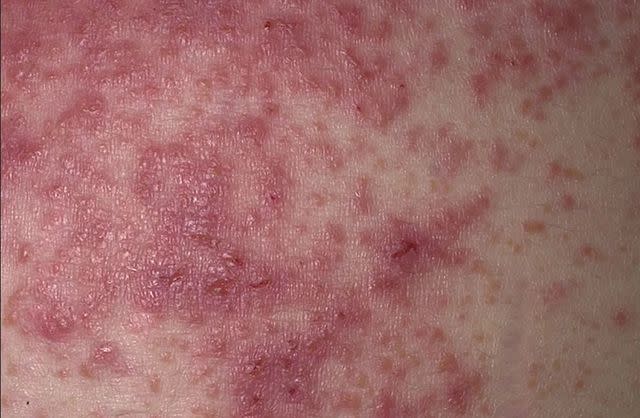
Dermnet/Creative Commons
Dermatitis herpetiformis can look like other skin conditions, but there are certain characteristics that provide clues that celiac disease may be involved:
Location
Although dermatitis herpetiformis can develop on any part of the body, it is most commonly seen on the extensor surfaces (the skin on the outside of joints), such as the elbows, knees, buttocks, ankles, groin, and back of the neck.
Onset of Symptoms
Dermatitis herpetiformis develops suddenly and can last for weeks to months. Outbreaks can occur within hours or days of eating gluten.
By contrast, a rash caused by a wheat allergy (caused by an allergy rather than autoimmunity) often develops within two hours.
Appearance
The dermatitis herpetiformis rash has distinctive reddish-purple, fluid-filled bumps that can be as small as a pinhead or as large as a dime.
The rash tends to come and go in episodic flares (exacerbations). After a blister ruptures, it usually takes several days to heal, during which new bumps can develop nearby.
Sensations
A dermatitis herpetiformis rash can be intensely itching and is often accompanied by a burning sensation.
During outbreaks, a person may be unable to resist scratching. This can cause scarring and the appearance of reddish skin and purplish marks that can last for weeks or months, or be permanent.
Symmetry
As with autoimmune diseases like rheumatoid arthritis and vitiligo, dermatitis herpetiformis develops symmetrically, meaning that it affects the same skin surface on both sides of the body at once.
Related: How Celiac Disease Is Diagnosed
Severe Dermatitis Herpetiformis
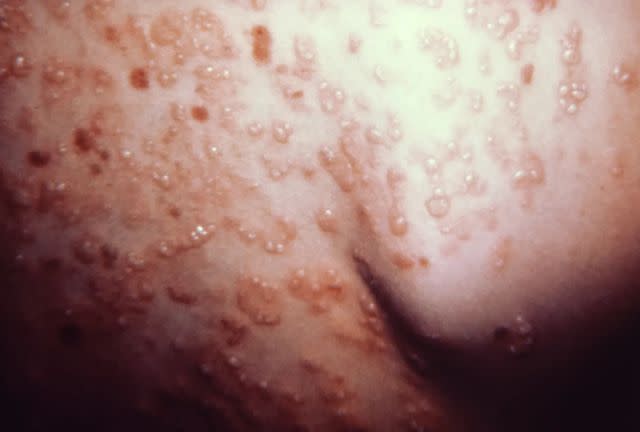
Centers for Disease Control and Prevention
This photo shows a severe case of dermatitis herpetiformis in a 4-year-old child.
Dermatitis herpetiformis most often starts between the ages of 30 and 40, though people of any age can be affected. The condition had long been considered rare in children under 10, but more cases have been identified in recent years.
Most cases are chronic (persistent or recurrent), with the frequency of outbreaks varying from one person to the next. In the majority of cases, the outbreaks will occur on the same part of the body every time.
Dermatitis Herpetiformis on the Lower Limbs
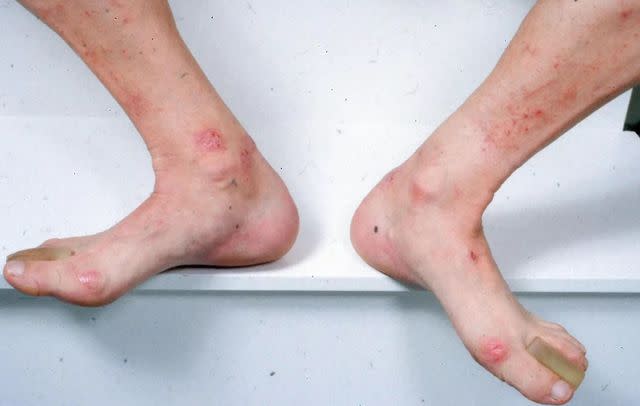
BallenaBlanca / Creative Commons
Because of its appearance and itchiness, a dermatitis herpetiformis rash is often mistaken for other skin conditions, such as:
Allergic contact dermatitis: This is a rash caused by contact with an allergy-causing substance (allergen).
Irritant contact dermatitis: This is a rash caused by contact with certain irritants that trigger a non-allergic immune reaction.
Shingles: This is a blistering rash caused by the reactivation of the same virus that causes chickenpox, called the varicella-zoster virus (VZV).
Eczema: Also known as atopic dermatitis, this is a chronic allergy-related condition closely linked to food allergies, hay fever, and asthma.
Psoriasis: This is an autoimmune disease that causes the overgrowth of skin cells that form into scaly, flaky patches of skin.
Scabies: This is a skin condition caused by an infestation of mites (Sarcoptes scabiei) that burrow their way into the skin to lay their eggs.
One of the things that differentiates dermatitis herpetiformis from similar skin conditions is that the rash typically develops symmetrically.
Allergic contact dermatitis, irritant contact dermatitis, and shingles all develop asymmetrically, while eczema, psoriasis, and scabies can either be symmetrical or asymmetrical.
Dermatitis Herpetiformis on the Abdomen
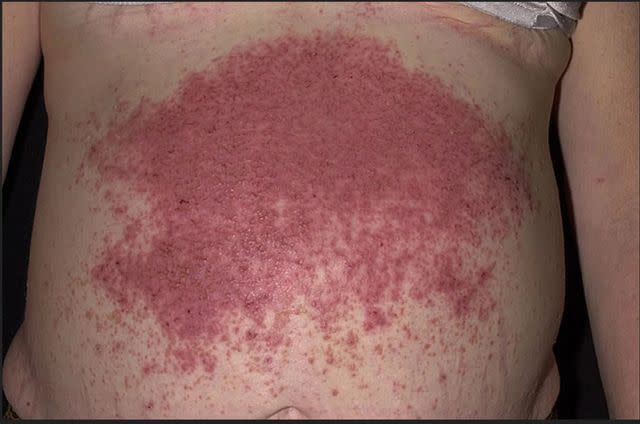
Dermnet / Creative Commons
This photo shows a dermatitis herpetiformis outbreak on the abdomen. Note the symmetrical presentation of the rash.
Dermatitis herpetiformis isn't the only skin condition linked to celiac disease. Eczema—a condition common in children but also seen in adults—may be associated with both celiac disease and non-celiac gluten sensitivity.
Psoriasis—common starting between the ages of 20 and 30 or later between the ages of 50 and 60—also shares a strong link with celiac and gluten sensitivity.
However, dermatitis herpetiformis has the strongest link to celiac disease of any skin condition. All told, between 15% to 25% of people with celiac disease also have dermatitis herpetiformis.
If you've been diagnosed with dermatitis herpetiformis, you almost certainly have celiac disease.
Dermatitis Herpetiformis on the Hands
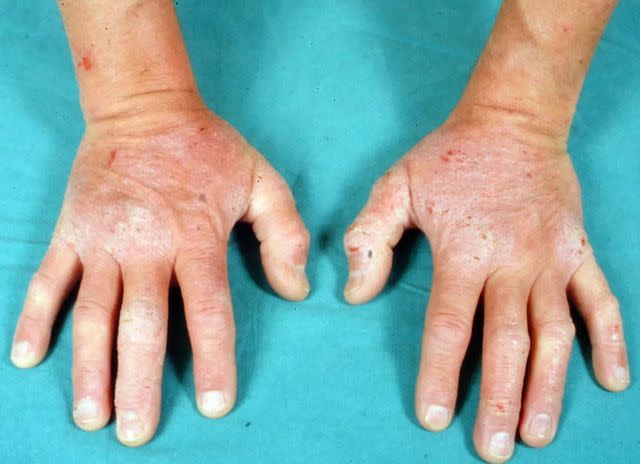
BallenaBlanca / Creative Commons
It's somewhat unusual to see dermatitis herpetiformis on the hands, but the rash can ultimately occur anywhere on the body.
Dermatitis herpetiformis is more common in males, unlike celiac disease which is diagnosed more often in females. In fact, some studies suggest that males are twice as likely to have dermatitis herpetiformis than females.
There has been relatively little research done on the health risks associated with dermatitis herpetiformis. Some studies show an increased risk of osteopenia (thinning bones) in nearly two of every five people with dermatitis herpetiformis.
Other studies have reported an increased risk for thyroid disease—not surprising given that celiac disease and autoimmune thyroid disease (like Hashimoto's thyroiditis or Graves disease) are often diagnosed together.
How Dermatitis Herpetiformis Is Diagnosed
Dermatitis herpetiformis is diagnosed with a combination of a blood test and skin biopsy.
The blood test looks for immune proteins, called immunoglobulin A (IgA) antibodies that are closely associated with dermatitis herpetiformis.
With the biopsy, a small sample of skin is removed for evaluation in the lab. If you have dermatitis herpetiformis, the sample will show deposits of IgA between the top and middle layers of skin (called the epidermis and dermis) when examined under a microscope.
Your healthcare provider may also order a biopsy of the small intestine to confirm if celiac disease is involved. With celiac disease, there will be villous atrophy, a condition characterized by the loss of tiny, finger-like projections on the lining of the intestinal tissues called villi.
Related: Skin Biopsy for Dermatitis Herpetiformis: What to Expect
How Dermatitis Herpetiformis Is Treated
Currently, the only long-term treatment for dermatitis herpetiformis is a gluten-free diet.
The oral antibiotic dapsone may be prescribed for the short-term relief of symptoms, but it can cause significant side effects in some people, including nausea, vomiting, dizziness, blurred vision, insomnia, lightheadedness, fatigue, and tinnitus (ringing in the ears).
For this reason, dapsone is used sparingly to help bring the rash under control.
Summary
Dermatitis herpetiformis is an autoimmune skin condition linked to celiac disease that causes an intensely itchy rash with tiny fluid-filled blisters. Between 15% and 25% of people with celiac disease have dermatitis herpetiformis.
The rash usually affects areas of skin on the outside of a joint (such as the knees or elbows) on both sides of the body, The condition can come or go but tends to affect the same body part each time. Severe cases can cause scarring and ongoing redness.
The most effective treatment for dermatitis herpetiformis is a gluten-free diet, though the oral antibiotic dapsone may help resolve the rash and relieve itching and discomfort.
Read the original article on Verywell Health.

